David Keys
Source -http://www.independent.co.uk/news/science/archaeology/biggest-ever-collection-of-chinese-artefacts-set-to-arrive-in-britain-7685114.html
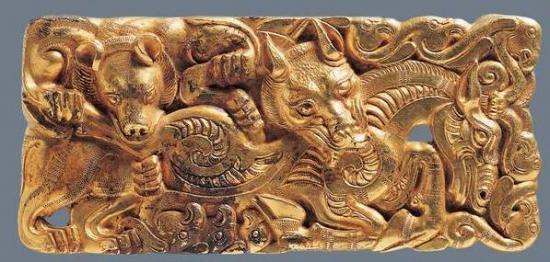
Gold Belt Plaque, 2nd century BC, Western Han Dynasty, Length: 13.3 cm; Width: 6 cm. Excavated from Shizishan, Xuzhou - Xuzhou Museum, Jiangsu Province.
The treasure troves of jade, bronze, gold, silver and other artefacts from more than a dozen 2000 year old royal tombs are the product of the modern world’s greatest series of archaeological discoveries. Revealing a bizarre quest for eternal life, they represent an archaeological bonanza equivalent in scale to that which unearthed ancient Egypt a century or more earlier. For over the past three decades, Chinese archaeologists have excavated the tombs of more than 40 ancient Chinese kings and their consorts – and at least a further 100 remain to be discovered.
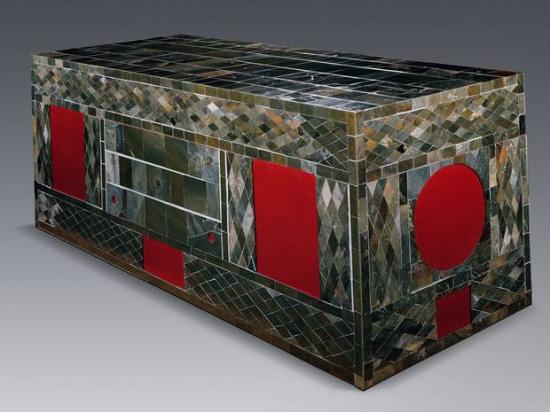
Jade Coffin, 2nd century BC, Western Han Dynasty, Length 280 cm; Width: 110 cm; Height: 108 cm. Unearthed at Shizishan 1994-199 - Xuzhou Museum, Jiangsu Province
Most of the ancient Chinese royal tombs – from which the newly arrived loaned treasures come - were quite literally carved out of the living rock inside a series of hills and mountains across China. Secret passageways had been cut into mountains and hillsides so that suites of funerary rooms could be created deep underground.
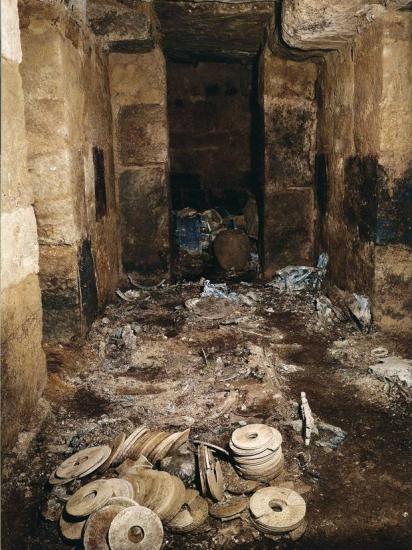
The scene that greeted archaeologists when they entered the King’s Coffin Chamber during the excavation of the tomb complex of the king of Nanyue, South China in 1983. Photo courtesy of The Museum of the King of Nanyue
Only now, after dozens of excavations, is the full bizarre story of China’s ‘mountains of the kings’ being revealed. The evidence suggests that royal servants were often sacrificed – so they could prepare banquets for the dead kings in the afterlife. Treasures from just such a sacrificial royal tomb are among the precious artefacts due to go on display at Cambridge.
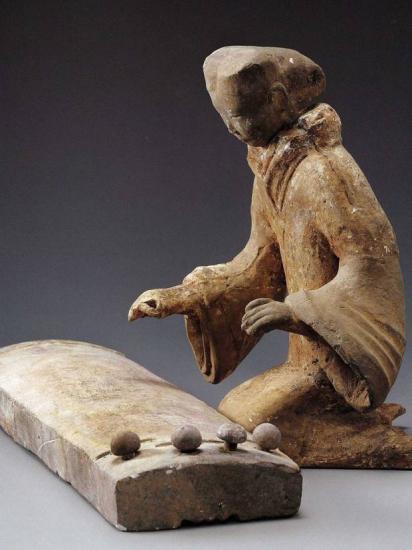
Pottery Musician, 2nd century BC, Western Han Dynasty, Height: 33 cm. Unearthed from Tuolanshan King of Chu tomb 1989 - Xuzhou Museum, Jiangsu Province
But it wasn’t just gourmet foods that the kings thought they would need in paradise. Skeletal evidence has revealed that some kings also took their concubines with them. Of the 40 kings’ tombs excavated so far, half a dozen had evidence that servants, concubines or others had been ‘sacrificed’ so that they could accompany their royal masters. The excavations are also gradually revealing the lengths to which, even after death, ancient Chinese royal rulers were prepared to go to protect themselves from their enemies. The world famous Terracotta Warriors – a lifeless ‘army’ created to protect the dead body of China’s first emperor - was originally thought to be a unique find. But over recent decades, three other terracotta armies have been discovered – guarding other ancient rulers and leaders throughout China. The Cambridge exhibition will feature 25 such warriors, as well as four ceramic horses and 14 terracotta dancers, officials and musicians.
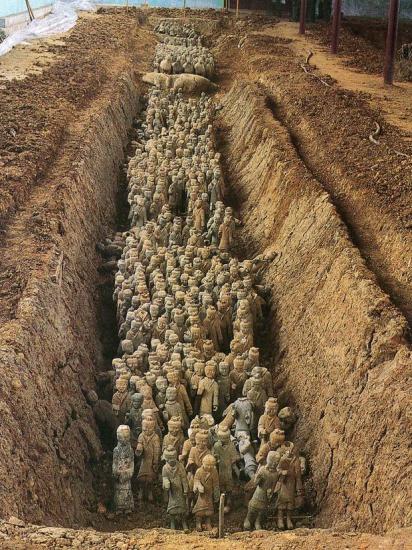
Another terracotta army: Ceramic soldiers of the second century BC stand on eternal guard duty - protecting the king of the northern Chinese kingdom of Chu. Excavation - Xuzhuo (pottery figures). Terracotta warrior pits from Shizishan - Photo courtesy of Xuzhou Museum
Although the original terracotta soldiers (the ones created to guard China’s first emperor) were all life size, those guarding kings (one rank down from emperors!) were sculpted at one-third scale. Even inside the tombs themselves, China’s ancient monarchs (usually hereditary local rulers related to the emperor) sought to protect themselves. They stored magic pills and minerals (to try to ensure eternal life) and created tomb arsenals (complete with cross bows, spears and swords) – and they arranged to have themselves covered in jade – to prevent their enemies sending evil spirits to gain access to their bodies – the cause, they thought, of decomposition. So far, archaeologists have found a dozen complete jade suits – each made up of up to 4,000 pieces of the precious rock, sometimes sown together with golden thread. However scholars estimate that at least 50 more await discovery in thus far undiscovered mountain tombs. The finest example found so far is among the items going on display at Cambridge. So desperate were China’s ancient kings to keep evil spirits out of their bodies after death – and to keep perceived ‘life forces’ in – that they arranged to have all their bodily orifices posthumously blocked with plugs made of solid jade.
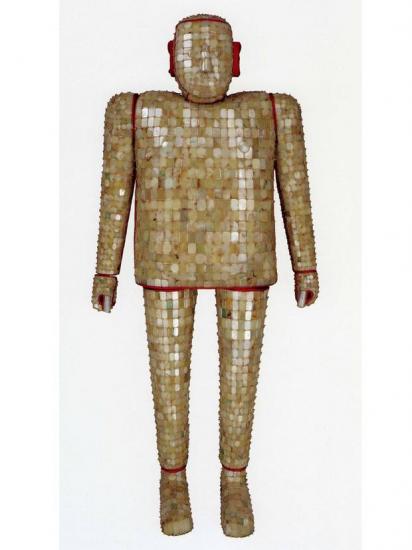
This jade suit was designed in the second century BC in the hope that it would protect a dead king's body from attack by evil spirits sent by his enemies. It was thought that decomposition was caused by the activities of evil spirits. Second century BC, Western Han Dynasty Length: 175 cm; Width: 68 cm. Unearthed at Shizishan in 1994-1995 – Xuzhou Museum, Jiangsu Province
The Cambridge exhibition – curated by the Fitzwilliam’s head of Asian antiquities, Dr. James Lin - will be dominated by jade. Two jade suits (a total of 6000 pieces of jade) and a jade-covered coffin (1200 pieces) will be on display, as will 60 other jade artefacts from 14 tombs. Research has revealed the names of three of the dead kings whose treasures they were – Liu Yin Ke (the nephew of the first Han Emperor and second ruler of the kingdom of Chu in north China), Liu Zhu (the 6th king of Chu ) and Zhao Mo (second king of Nan Yue in south China). The excavations of recent years have revealed that jade massively increased in importance after China was unified in the late 3rd century BC. With unification came a vast increase in the centralization of political power – and the growing wish to defeat the reality of death (with the aid of jade and other substances) may well have been a logical extension of that power-oriented phenomenon. Even as the royal tomb treasures go on display at Cambridge, China’s archaeologists are excavating yet another major royal tomb (at Xugu, near Nanjing, eastern China) – complete with a jade covered coffin, life-size chariots, gilt bronze statues of wild animals (a rhino and an elephant !) – and yet another spectacular jade suit.
The Cambridge exhibition - The Search for Immortality: Tomb Treasures of Han China – features 350 high status archaeological finds, opens at the Fitzwilliam Museum on Saturday 5 May and will remain on show until 11 November.